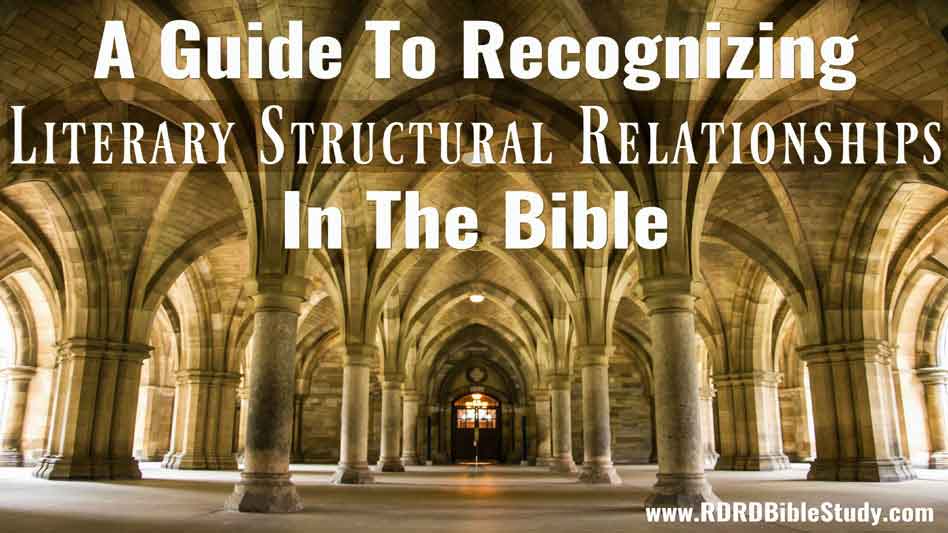A Guide To Recognizing Literary Structural Relationships In The Bible
The most elemental factor in discovering the meaning of a biblical passage is context—historical, literary, and theological. The “structure” of a text belongs to the realm of literary context. Structure is how the writer organizes the material. “Structural relationships” are how a sequence of ideas links the ideas together. (Say that three times fast!) For example:
- Easy Sequence of Ideas:
- Idea A
- And Idea B
- And Idea C
Since structural relationships are how a sequence of ideas links the ideas together, the structural relationships in this easy sequence of ideas are the two “ands.” Being able to recognize the multiple types of structural relationships used in the Bible enables the astute student (that’s you) to recognize the author’s division within the text and therefore, interpret the text more precisely.
Literary Context In A Nutshell
Sometimes it seems that everything related to literary context says the same thing over and over. That’s because so much of it overlaps. Still—and I wish I had paid more attention in English Lit 101—it helps to maintain a general understanding of the various components. Here’s a quick overview (if you don’t need it, skip to the next section):
Literary Context includes the following:
- Genre – style, form, and content
- Structure of the language, primarily including (but not limited to):
- Syntax – the study of the formation of sentences
- Semantics – the study of meaning
- Pragmatics – the study of language use
Literally all texts have a literary context. Whether it is a newspaper, Shakespearean poetry, a contemporary best seller, or any other type of reading material, all have a literary context. The Bible also has a literary context.
And all 66 books of the Bible have literary contexts. The books of the Bible also represent multiple genres. Each book’s genre is the first thing to be addressed in literary contextual study.
And quite possibly the most important concept in biblical study is that “A text without a context is a pretext to a proof text.” Context is a huge deal.
When studying the context of a passage, two literary components must be examined:
- Theme – the central idea of the entire section of the book where the study passage is located
- Structure – how the writer organizes the material
Literary Context Is Multi-Faceted: Where Do Structural Relationships Fit In?
Overall structure can be based on genre and/or the structure of the language. The structure of the text is held together by structural relationships which can be intermingled in the various facets of literary context included above.
- Structure is how ideas link together or how the writer organizes the material.
- Structural relationships are how a sequence of ideas links the ideas together
Close-up view showing the great industrial metal structural relationships—how the structure is held together—of one of the most famous landmarks in the world. Do you know what it is? Keep reading (or scroll down) to check your answer.
Literary Structure
Passages are linked by common themes and they are also linked by structure. Evaluating the structure helps to explain the relationship between the study passage and the surrounding paragraphs or sections.
Each sentence in the given passage must be understood in a way consistent with the general theme of the context.
Likewise, that sentence must also be interpreted according to the paragraph’s structural relationship with the adjoining material.
Recognizing Literary Structural Relationships
This post is a guide to recognizing mechanisms used for fitting the material together within the larger framework of literary structure. These mechanisms are called structural relationships. Structural relationships exist in all textual contexts.
Unless otherwise noted, the various types of structural relationships apply to all portions of the Bible. The examples used below represent a typically sized study passage, but the concepts apply to virtually any size text.
Structural Relationships In The Bible
The Biblical writers used many different types of structural relationships.
Chronological
Historical narratives typically advance using chronology. Chronological structural relationships are normally temporal adverbs and/or conjunctions.
For example:
- Exodus 3:1 – Now Moses was keeping the flock of his father-in-law…
- Exodus 3:4 – When the LORD saw that he turned aside to see…
- Exodus 3:7 – Then the LORD said…
- Exodus 3:13 – Then Moses said to God…
Examples of other temporal adverbs and conjunctions that indicate continuance are: after, afterwards, later, thereafter, later, soon, earlier, immediately, etc., as well as the ones listed in the example, now, when, then.
More Than One Way To Link A Chronological Phrase
From the close-up structural relationship image above, if you guessed Eiffel Tower, you are correct! And I bet you’ve never looked closely at “this part” of the Eiffel Tower before. Am I right? Studying and evaluating the structural relationships up close provides greater depth and perception—and awe— of the whole.
And I bet you’ve never looked closely at “this part” of the Eiffel Tower before. Am I right?
Studying and evaluating the structural relationships up close provides greater depth and perception—and awe— of the whole.
Literary structure linked together chronologically, may also employ a phrase to indicate relationsip. For instance, the OT Narrative of Genesis obviously uses chronological relationships. But it also uses an organizing phrase that announces the narrative subject of the upcoming major division of the book:
- Genesis 2:4 – These are the generations of the heavens and the earth…
- Genesis 5:1 – This is the book of the generations of Adam…
- Genesis 6:9 – These are the generations of Noah…
The phrase “These are the generations…” announces the Abraham narratives, as well as Issac, Jacob and other OT figures in Genesis. It provides a narratival structure that represents not only subject, but forward movement in time.
Thematic Continuity
Material structured according to theme, or central idea, has a structural relationship called thematic continuity. This structural relationship can be seen throughout the Bible and at differing levels.
For example – Gospels:
In the Gospels. Matthew, Mark, Luke, and John gathered thematically related parables and teachings even though they did not occur at the same time.
Luke gathered the parables of the lost sheep, the lost coin, and the prodigal son into a single thematic section. Luke 15 exemplifies God’s love in fervently seeking the lost and the great joy He experiences when the lost are found.
- Luke 15:1-7 – The Parable of the Lost Sheep
- Luke 15:8-10 – The Parable of the Lost Coin
- Luke 15:11-32 – The Parable of the Prodigal Son
Matthew assembled teachings on the Kingdom of God in chapter 13. Within this larger theme, he placed parables that use the image of “seeds.”
- Matthew 13:1-9 – The Parable of the Sower – “hearing the word of the Kingdom”
- Matthew 13:10-17 – The Purpose of Parables
- Matthew 13:18-23 – The Parable of the Sower explained
- Matthew 13:24-30 – The Parable of Weeds among the Wheat – “The kingdom of heaven may be compared to a man who sowed good seed…”
- Matthew 13:31-32 – The Parable of the Mustard Seed – “The kingdom of heaven is like a grain of mustard seed…”
- Matthew 13:33 – The Parable of the Yeast – “The kingdom of heaven is like leaven…”
- Matthew 13:34-35 – The Use of Parables
- Matthew 13:36-43 – Jesus Explains the Parable of the Weeds – “The one who sows the good seed is the Son of Man…”
- Matthew 13:44-50 – Three Parables
- “The kingdom of heaven is like treasure hidden in a field…” (44)
- “The kingdom of heaven is like a merchant in search of fine pearls…” (45-46)
- “The kingdom of heaven is like a net…” (47-50)
- Matthew 13:51-53 – Treasures New and Old – “Every scribe who has been trained for the kingdom of heaven is like a master of a house…”
For example – OT Law:
Leviticus assembles thematic sections on offerings, skin diseases, festivals and holidays, clean and unclean foods, etc.
For example – OT Historical Narrative:
Judges also has thematic sections:
- Judges 2:3-26 – the main theme is predicated on the failure of the people to drive out all the inhabitants of the land and Joshua’s death; the people fall into apostasy, become oppressed by those in the land, cry out for help, God sends a judge to deliver them, there is peace for a certain number of years, then the entire cycle begins again
- Judges 3-16 – illustrates multiple cycles of the main theme through the adventure of the judges
- Judges 17-21 – suggests the spiritual decline of Israel is based on a lack of leadership
For example – OT Canon:
On the larger scale of the entire OT, books are thematically arranged. In the English canon, Judges thematically prepares for the book of Ruth and 1 Samuel. Judges paints the spiritual decline of the nation, but Ruth paints the righteousness of the residents of Bethlehem during the same time period:
In the days when the judges ruled there was a famine in the land, and a man of Bethlehem in Judah went to sojourn in the country of Moab, he and his wife and his two sons. Ruth 1:1
In 1 Samuel, the unrighteous masses demand a king, though God was to be their King. Through God’s instruction, Samuel anoints Saul as King which doesn’t work out so well. Then he anoints David, a man after God’s own heart, and a resident of Bethlehem.
For example – OT Hebrew Canon:
The Hebrew canon is structured thematically into three sections: Law—Prophets—Writings.
For example – NT:
Likewise, the NT has all of the Gospels together, all of Paul’s letters together, etc.
Logical Order
Logical Order is another structural relationship which is the organizing principle for most of the OT Prophets, NT Epistles, and Bible speeches. Logical arrangement can be found in many forms.
Introduction to Biblical Interpretation lists some structural patterns used by authors to develop a logical line of thought:
- Introduction preparing for what follows
- Explanation clarifying the meaning
- Illustration citing an example or instance
- Causation showing cause and effect
- Instrumentation demonstrating the means to an end
- Interrogation giving a question and answer
- Evidence proving the stated point
- Particularization stating the details
- Generalization drawing a general principle from details
- Interchange alternating sequence
- Cruciality pivot marking change of direction
- Climax indicating progression from lesser to greater
- Continuation extending an idea
- Continuity restating the same idea
- Repetition restating the same words for emphasis
- Comparison showing similarity to something else
- Contrast showing difference from something else
- Summarization reviewing main points briefly
- Conclusion drawing inferences or bringing to an end
Determining how each paragraph functions in the logical flow of thought in the context provides valuable perspective for appreciating the significance of the passage.
For example – Galatians 1
Using the designations above:
Introduction Paul, an apostle- not from men nor through man, but through Jesus Christ and God the Father, who raised him from the dead – 2 and all the brothers who are with me, To the churches of Galatia: 3 Grace to you and peace from God our Father and the Lord Jesus Christ, 4 who gave himself for our sins to deliver us from the present evil age, according to the will of our God and Father, 5 to whom be the glory forever and ever. Amen. (Galatians 1:1-5)
Cruciality I am astonished that you are so quickly deserting him who called you in the grace of Christ and are turning to a different gospel- 7 not that there is another one, but there are some who trouble you and want to distort the gospel of Christ. 8 But even if we or an angel from heaven should preach to you a gospel contrary to the one we preached to you, let him be accursed. 9 As we have said before, so now I say again: If anyone is preaching to you a gospel contrary to the one you received, let him be accursed. (Galatians 1:6-9)
Interrogation For am I now seeking the approval of man, or of God? Or am I trying to please man? If I were still trying to please man, I would not be a servant of Christ. (Galatians 1:10)
Explanation For I would have you know, brothers, that the gospel that was preached by me is not man’s gospel. 12 For I did not receive it from any man, nor was I taught it, but I received it through a revelation of Jesus Christ. 13 For you have heard of my former life in Judaism, how I persecuted the church of God violently and tried to destroy it. 14 And I was advancing in Judaism beyond many of my own age among my people, so extremely zealous was I for the traditions of my fathers. 15 But when he who had set me apart before I was born, and who called me by his grace, 16 was pleased to reveal his Son to me, in order that I might preach him among the Gentiles, I did not immediately consult with anyone; 17 nor did I go up to Jerusalem to those who were apostles before me, but I went away into Arabia, and returned again to Damascus. (Galatians 1:11-17)
Evidence Then after three years I went up to Jerusalem to visit Cephas and remained with him fifteen days. 19 But I saw none of the other apostles except James the Lord’s brother. 20 (In what I am writing to you, before God, I do not lie!) 21 Then I went into the regions of Syria and Cilicia. 22 And I was still unknown in person to the churches of Judea that are in Christ. 23 They only were hearing it said, “He who used to persecute us is now preaching the faith he once tried to destroy.” 24 And they glorified God because of me. (Galatians 1:18-24)
Use of Conjunctions in Logical Order Relationships
Sometimes conjunctions are used at the beginning of a paragraph to indicate logical connections. When specific logical connectives are used, it makes the task of identifying structural relationships much simpler. However, writers do not always use these type of connectives so the type of logical relationship must be inferred from the content.
For example – Mark 14:
Mark 14:1-2 – (chronological) It was now two days before the Passover and the Feast of Unleavened Bread. And the chief priests and the scribes were seeking how to arrest him by stealth and kill him, 2 for they said, “Not during the feast, lest there be an uproar from the people.”
Mark 14:3-9– And while he was at Bethany in the house of Simon the leper, as he was reclining at table, a woman came with an alabaster flask of ointment of pure nard, very costly, and she broke the flask and poured it over his head. 4 There were some who said to themselves indignantly, “Why was the ointment wasted like that? 5 For this ointment could have been sold for more than three hundred denarii and given to the poor.” And they scolded her. 6 But Jesus said, “Leave her alone. Why do you trouble her? She has done a beautiful thing to me. 7 For you always have the poor with you, and whenever you want, you can do good for them. But you will not always have me. 8 She has done what she could; she has anointed my body beforehand for burial. 9 And truly, I say to you, wherever the gospel is proclaimed in the whole world, what she has done will be told in memory of her.”
Mark 14:10-11 – (chronological) Then Judas Iscariot, who was one of the twelve, went to the chief priests in order to betray him to them. 11 And when they heard it, they were glad and promised to give him money. And he sought an opportunity to betray him.
Mark 14:12-16 – And on the first day of Unleavened Bread, when they sacrificed the Passover lamb, his disciples said to him, “Where will you have us go and prepare for you to eat the Passover?” 13 And he sent two of his disciples and said to them, “Go into the city, and a man carrying a jar of water will meet you. Follow him, 14 and wherever he enters, say to the master of the house, ‘The Teacher says, Where is my guest room, where I may eat the Passover with my disciples?’ 15 And he will show you a large upper room furnished and ready; there prepare for us.” 16 And the disciples set out and went to the city and found it just as he had told them, and they prepared the Passover.
Mark 14:17 – And when it was evening, he came with the twelve…
The above example uses paragraph breaks found in the various major bible translations to illustrate structural relationships between sections. Each section could also be broken into sub-sections. Along with the two chronological structure markers, note how the conjunctions also denote chronology:
- Mark 14:1 It was not two days
- Mark 14:3 And while he was at Bethany…
- Mark 14:10 Then Judas Iscariot… went…
- Mark 14:12 And on the first day…
- Mark 14:17 And when it was evening…
And in the following sections of Mark 14, note how the conjunctions mark the advancement of the narrative. Mark 14:1-17 uses conjunctions and chronological time, i.e. day, evening, etc., to advance the narrative. Mark 14:22-66 uses conjunctions and events on the evening prior to Jesus’ crucifixion, from the Last Supper to Peter’s betrayal.
- Mark 14:22 And as they were eating…
- Mark 14:26 And when they had sung a hymn
- Mark 14:32 And they went to a place called Gethsemane.
- Mark 14:43 And immediately, while he was still speaking….
- Mark 14:51 And a young man followed him…
- Mark 14:53 And they led Jesus to the high priest
- Mark 14:66 And as Peter was below in the courtyard…
Other Hints For Detecting Structural Relationships
Literary Genre
Literary Genre plays a key role in structural relationships. Multiple genres and sub-genres are found throughout the OT and NT. An OT Narrative will have a different structure than OT Poetry or a NT letter, etc. Likewise, they will use structural relationships relevant to that genre.
A NT epistle follows conventions of first century letter writing. One component of an epistle is the letter opening formatted as
- Name of sender and an optional sender description
- Name of Addresee
Note how each of these letters conform to this structure:
- Ephesians 1:1 – From: Paul, an apostle of Christ Jesus by the will of God, To: To the saints who are in Ephesus, and are faithful in Christ Jesus.
- Colossians 1:1-2 – From: Paul, an apostle of Christ Jesus by the will of God, and Timothy. our brother, To: To the saints and faithful brothers in Christ at Colossae: Grace to you and peace from God our Father.
- James 1:1 – From: James, a servant of God and of the Lord Jesus Christ, To: To the twelve tribes in the Dispersion: Greetings.
Psychological Transfer
Psychological Transfer describes a “complete change of subject” between passages. These occur when one subject triggers a cognitive prompt to a different subject. In the mind of the writer a connection between the thoughts exists. But it may or may not be apparent to the reader. More than likely, it was understood by the original hearers.
Psychological transfers can be fun to figure out. Attempt to discover the writer’s frame of reference and the likely connection between the two seemingly disparate thoughts.
An example of a psychological transfer most likely explains the complete change of subject found in 2 Corinthians 6:11-7:2.
In 2 Corinthians 6:11-13 Paul reminds the church at Corinth of the wide hearts that he and his associates have displayed toward them and exhorts them to do likewise. Then 2 Corinthians 6:14 jumps to “do not be unequally yoked…” This theme is taken up through 2 Corinthians 7:1. Then in the following verse (7:2) Paul picks back up with “make room in your hearts for us…”
- 2 Corinthians 6:11-13 We have spoken freely to you, Corinthians; our heart is wide open. 12 You are not restricted by us, but you are restricted in your own affections. 13 In return (I speak as to children) widen your hearts also.
- 2 Corinthians 6:14-7:1 Do not be unequally yoked with unbelievers. For what partnership has righteousness with lawlessness? Or what fellowship has light with darkness? 15 What accord has Christ with Belial? Or what portion does a believer share with an unbeliever? 16 What agreement has the temple of God with idols? For we are the temple of the living God; as God said, “I will make my dwelling among them and walk among them, and I will be their God, and they shall be my people. 17 Therefore go out from their midst, and be separate from them, says the Lord, and touch no unclean thing; then I will welcome you, 18 and I will be a father to you, and you shall be sons and daughters to me, says the Lord Almighty.” (7:1) Since we have these promises, beloved, let us cleanse ourselves from every defilement of body and spirit, bringing holiness to completion in the fear of God.
- 2 Corinthians 7:2-4 Make room in your hearts for us. We have wronged no one, we have corrupted no one, we have taken advantage of no one. 3 I do not say this to condemn you, for I said before that you are in our hearts, to die together and to live together. 4 I am acting with great boldness toward you; I have great pride in you; I am filled with comfort. In all our affliction, I am overflowing with joy.
What is Paul’s frame of reference? What is going on with the Corinthian church that would cause Paul’s psychological jump? As you evaluate Paul’s psychological transfer, don’t edit yourself. Using Acts and the other letters, try and determine what is going on in Paul’s life. Factor in what is known about Paul, i.e. his deep concern for the churches, his heartfelt urgency in preaching the Gospel and obedience to Christ, etc. Share your thoughts and leave a comment!
Abrupt Transitions
Abrupt Transitions occur when a new topic is introduced or when a break in the flow of thought takes place. Sometimes there is a transition and at other times it just happens. When considering the context for interpretation of a passage, abrupt transitions need to be taken into account. This prevents forcing a meaning based on context that the author did not intend.
Toward the end of Romans 11, the apostle is discussing obedience, disobedience, and the mercy of God, Then Paul abruptly breaks out in praise:
For God has consigned all to disobedience, that he may have mercy on all. 33 Oh, the depth of the riches and wisdom and knowledge of God! How unsearchable are his judgments and how inscrutable his ways! 34 “For who has known the mind of the Lord, or who has been his counselor?” 35 “Or who has given a gift to him that he might be repaid?” 36 For from him and through him and to him are all things. To him be glory forever. Amen. Romans 11:32-26
It seems this could double as psychological transfer as well! Amen? Considering God’s plan of salvation for Jews and Gentiles, Paul is overcome with reverence and joy toward God as he marvels at God’s wisdom and justice.
Literary Structural Relationships Conclusion
Being able to recognize literary structural relationships strengthens the ability to effectively study the Bible. Recognizing clues as to how the material is organized strengthens the effective study of the Bible because of structure’s critical role in a passage’s literary context. How the text fits together, i.e. how one sentence prepares for the next, and one section prepares for the next, obviously plays an important role in each author’s work. That makes structure important for students of the Bible as well.
Until Next time—
The grace of the Lord Jesus Christ and the love of God and the fellowship of the Holy Spirit be with you all. 2 Corinthians 13:14
Practicing What Is Preached
Let’s look at 2 Corinthians 13:14’s structural relationships.
2 Corinthians’ genre is NT letter, therefore, the beginning and ending will conform to first century letter writing standards. The context of the final benediction is part of the following paragraph:
- (11) Finally, brothers, rejoice. Aim for restoration, comfort one another, agree with one another, live in peace; and the God of love and peace will be with you.
- (12) Greet one another with a holy kiss.
- (13) All the saints greet you.
- (14) The grace of the Lord Jesus Christ and the love of God and the fellowship of the Holy Spirit be with you all.
Continuing the letter’s structural relationship of logical order, the final paragraph ends with “Finally.” The structure of the remainder of the paragraph is based on genre.
- v. 11 “Finally” – indicates the conclusion of logically ordered material; Paul also ties the conclusion thematically to the rest of the letter, by alluding to major themes throughout the letter; Also because it is the concluding exhortations, this represents the “takeaways” Paul wants to leave with his reader/hearer. As one of my NT professors used to say “Paul wants to leave this ringing in their ears.”
- v.12-13 –Paul issues final greetings conforming to the genre
- v. 14 – Paul issues a final benediction also conforming to the genre. In secular letters, the writer would conclude with a wish of health, safety, etc. “May you be safe in your travels…”. Therefore, in bible study, both the beginning and ending “wish” is sometimes called a “prayer wish.”












